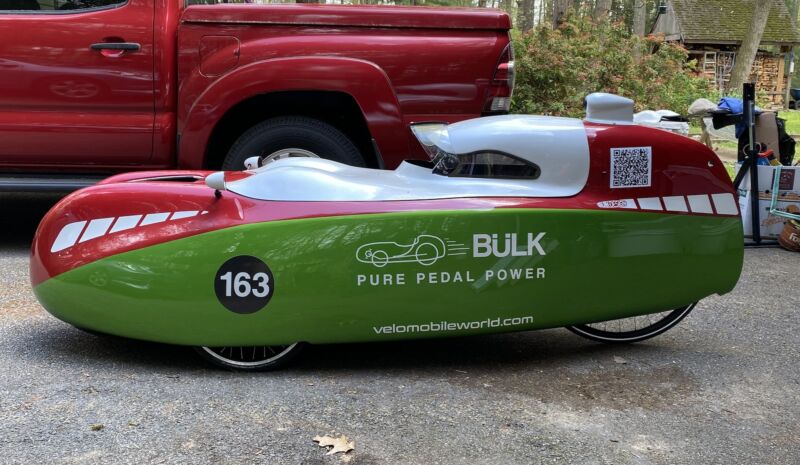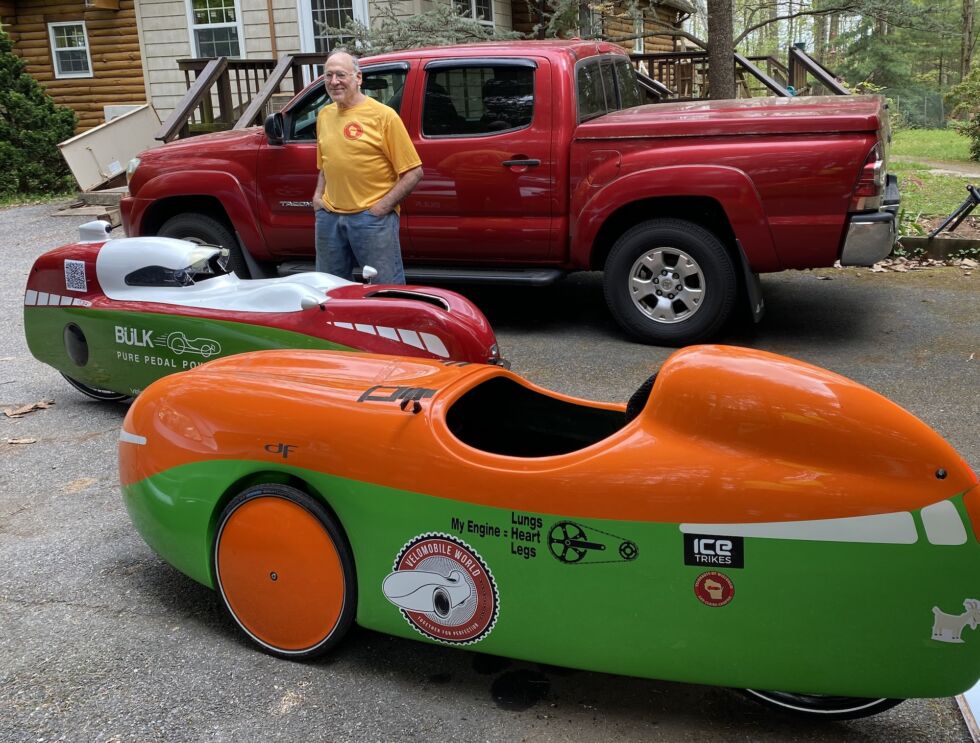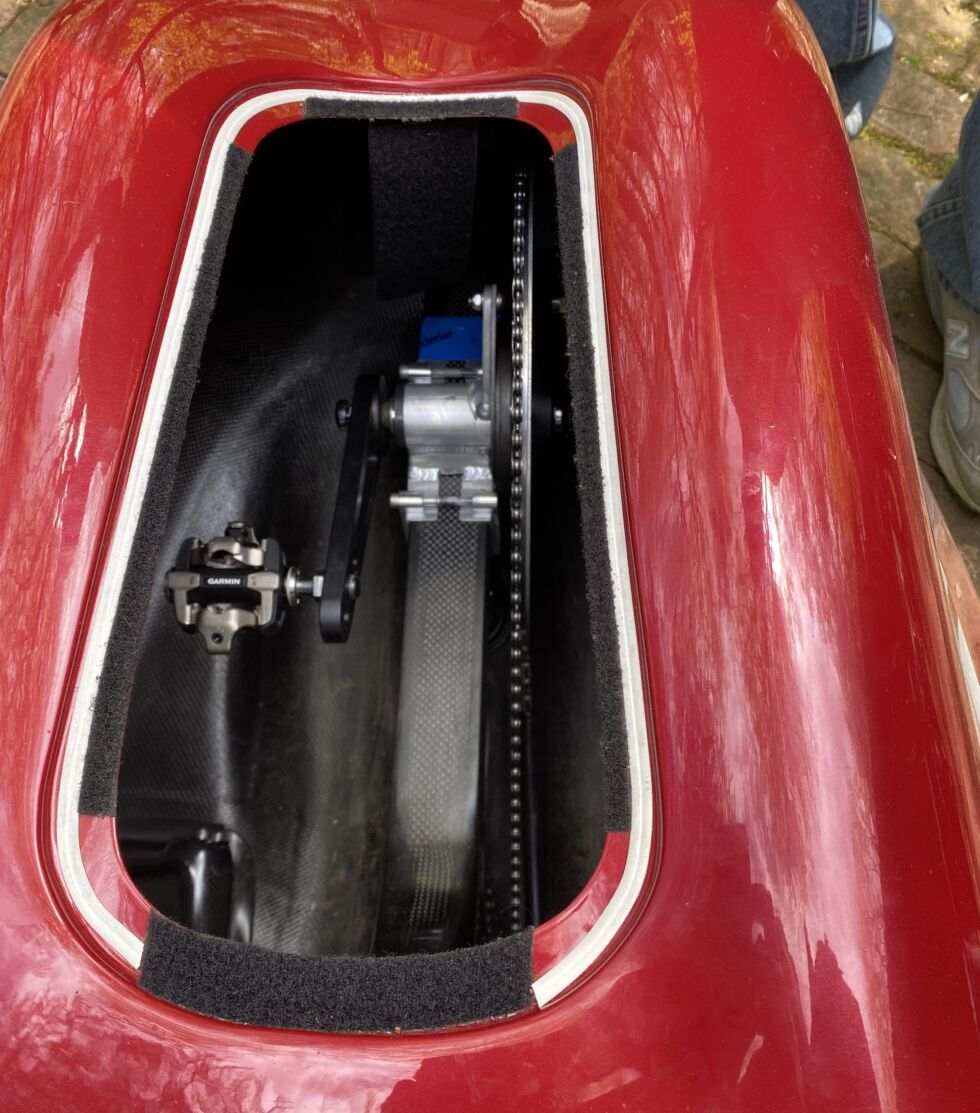Taking to the road in a modern, high-speed version of a 40-year-old dream.

My brain registered that I was clearly cycling. My feet were clipped in to pedals, my legs were turning crank arms, and the arms were linked via a chain to one of the wheels. But pretty much everything else about the experience felt wrong on a fundamental, almost disturbing level.
I could produce a long list of everything my mind was struggling to deal with, but two things stand out as I think back on the experience. The first is that, with the exception of my face, I didn’t feel the air flow over me as the machine surged forward down a slight slope. The second, related to the first, is that there was no indication that the surge would ever tail off if I didn’t hit the brakes.
Living the dream
My visit with a velomobile was, in some ways, a chance to reconnect with a childhood dream. I’ve always had a fascination with vehicles that don’t require fuel, like bicycles and sailboats. And during my childhood, the popular press was filled with stories about people setting human-powered speed records by putting aerodynamic fiberglass shells on recumbent bicycles. In the wake of the 1970s oil crises, I imagined a time when the roads might be filled with people cycling these pods for their commutes or covering long distances thanks to a cooler filled with drinks and snacks tucked in the back of the shell.
But the pods seemed to vanish from public consciousness as I got older, and I also learned that recumbent bikes are absolutely terrible on hills, which I’m now fond of climbing. The dreams had faded from my awareness when a reader, in response to one of our e-bike reviews, suggested I check out a velomobile. It turns out that my dreams weren’t dead; they had just relocated to Europe without mentioning it to me.

Velomobiles are a product category with a variety of designs and manufacturers producing them, most of them based in Europe. They’re also the fiberglass pods of my youth updated to current standards. Gone is the weight of fiberglass, and the one-off, hand-made hardware has been replaced by standardized models that have gone through refinements across generations. Safety features like lights, directionals, and mirrors are now standard.
But the prices, while not exorbitant (mostly in the $8,000–$10,000 range—for bicycles; you can pay more for far less carbon fiber), mean that living my childhood dream really wasn’t an option. The European Union-based companies don’t seem to have any agreements with US bike shops that would let me check one out in a showroom; I’ve heard of only two dealers in the US that keep velomobiles in stock, and neither is anywhere close to me. Fortunately, that didn’t preclude the option of trying one. One major vendor of velomobiles, Romania’s Velomobile World, has an ambassadors program, where people agree to let potential buyers take test rides in return for a discount on purchases.
That’s how I found myself setting out for a short spin near the Maryland-Pennsylvania border in a Velomobile Bülk owned by Marc Rosen, who also fielded a lot of my questions about the hardware.
ARS VIDEO
How Scientists Respond to Science Deniers
In Bülk
A velomobile is typically a tricycle with two forward wheels and one in the rear (there’s at least one four-wheel design). This adds stability that’s critical for two reasons. The first is that there’s a lot of flat surface to catch crosswinds, which could potentially topple a two-wheeled version over. The second, as mentioned earlier, is that these things are terrible on climbs since you can’t force your entire body weight down on the pedals. Rosen said the three-wheeler’s stability allows him to crawl up hills in an extremely low gear at a pace that might be slow enough to cause a two-wheeled bike to fall over.
The tricycle itself is a fairly standard recumbent setup, with the cranks in front and slightly above the seat, which can be adjusted for different riders’ legs. The cranks typically have two chainrings and drive a chain that runs under the seat and to the rear axle, where there’s a standard derailleur. Rosen went for internal gearing on his. Hardware called a Schlumpf Drive allows him to shift between two gearings with a flick of his heel: either a direct drive from the full 65-tooth crank ring or a gearing that reduces the effective crank ring by a factor of 2.5, which is better for handling hills.
On the Bülk, all of this hardware is accessible from the exterior via carbon fiber panels held in place by velcro. To avoid the weight, lack of aerodynamics, and complexity of hinges and latches, the Bülk uses velcro extensively.
It’s typically recommended that you replace bike chains every 2,500 miles or so. But Rosen said that having a chain that’s far more protected from the environment extends the lifetime of velomobile chains considerably—many riders don’t find chain wear becomes extensive until 10,000 miles or more. That’s probably a good thing, as the distance between the cranks and rear derailleur requires three traditional bike chains linked together.

While many of the existing models place some wheels in wells, on the Bülk, they’re all fully encased. But the axle doesn’t extend through the wheel, so it’s possible to change tires and tubes simply by working your way around the wheel while operating on the small portion that extends below the bottom of the velomobile. Rosen said he typically flips his velomobile on the side on some grass, but he knows of other riders who carry blankets in the cargo space behind the rider. He also said that, in some of the company’s earlier models, this cargo space is large enough to carry two spare wheels that can be swapped in if needed.Advertisement
While the Bülk isn’t an e-bike, it does have an electrical system. A rechargeable battery powers headlights, directionals, and tail lights (the precise details of many of these systems are user-configurable at purchase). Also reminiscent of powered vehicles: side-view mirrors on either side of the body. There’s even a ventilation system, with an intake just under the nose in front leading to a vent pointed straight at the rider. The hood that covers the rider also has a vent that can be lowered to increase the airflow. After cooling you off, the air exits vents at the back.

All of this is encased in an extremely thin carbon fiber shell. In some ways, getting into the velomobile is like lowering yourself into a bathtub, except you need to be careful about only placing your feet where there’s some structural support. The fit is also very snug; I couldn’t lower my shoulders directly into the machine and had to duck them under the edge one at a time.
We also weren’t certain that my knees would have clearance under the hood, even though it’s shaped to specifically allow them a bit of space (I’m over 6 feet/190 cm tall, and much of that height is in my legs). There were some issues with my relatively large feet (US size 12/EU 46) hitting the shell as I pedaled; the cranks had three places to thread pedals in, so this could have been solved by moving the pedals inward.
The payoff for all that awkwardness? Aerodynamics. By the time a cyclist hits about 40 km/hr (25 mph), about 90 percent of the energy being put into the bicycle goes into overcoming the wind resistance. Get rid of much of that and it’s possible to power yourself to some mind-blowing speeds. Compared to record-setting aero cycles, a velomobile gives up just a bit of aerodynamic efficiency for a massive dose of user-friendliness.
Driving the tank
So what’s it like to ride one of these things? Despite having done so, I don’t think I can offer a fair description. Nearly everything about the ride is different from my normal cycling experiences, and it’s a lot to process all at once. For starters, the ground clearance on the Bülk isn’t that substantial, so I tried to be very conscious of the pavement quality and avoid areas where the machine might bottom out.
This required using the steering, called a “tank” configuration, after the treaded vehicles. Two grips are at the end of short poles nestled up against the left and right side of the shell; pulling back on one turns the bike in that direction. This is also where the brake handles live, and one has a toggle switch that works the directionals.

Getting comfortable with the steering and brakes also competed with my brain’s attempts to process the different sensations, as I mentioned above. One of the big sources of wind resistance that cyclists face is their own body; feeling the wind rushing over your shins is as much a part of the experience as feeling it on your face. And, well, it’s not part of the velomobile experience. Having skipped the hood, I at least got a bit of a breeze on the upper part of my face, but it’s possible to eliminate it entirely.
And then there’s the speed. What really stood out was a slight down slope—one that was barely perceptible pedaling back up in the opposite direction. On one of my normal bikes, without pedaling, I’d probably accelerate a bit until the slope and wind resistance offset each other. In the velomobile, there was no indication that the wind resistance would ever slow things down—I’d run out of slope first. I had to hit the brakes simply because I didn’t have confidence in my steering skills.Advertisement
I fully expect that with more experience with the controls, I’d feel less burdened with figuring everything out and could simply enjoy the good aspects of what appeared to be a very well-made machine. But that would take some time.
Who’s this for?
The area where Rosen lives is pretty hilly, so he recommended a very short out-and-back. But the experience was enticing enough to leave me interested in taking him up on his offer to meet up when he takes his machines to someplace flat over the summer. I’d like to do a long enough ride to get comfortable with the practicalities of riding and focus more on the experience.
Would I want one myself? To an extent, I’m not the typical user. Scroll through the stories of the people who serve as velomobile ambassadors and you’ll find a repeated theme: injuries that made using a traditional bicycle impossible, which forced dedicated cyclists onto recumbents. Later came the discovery of the velomobile as a better form of recumbent. (Rosen fits this description perfectly, with back problems relegating him to recumbents until the day a group of velomobiles blew past him during an organized ride.) The option to fully enclose the cabin also makes them appealing for people who ride in a variety of weather conditions—especially the cold and rain.
But they’re clearly not for everyone. One major barrier is the high price—$10,000 is a lot to spend on an “every now and then” machine. You’ll want to ensure your velomobile will get a lot of use, and that’s not likely to be the case if it’s just an addition to an existing stable.
Also, getting what I want out of cycling on a velomobile (meaning a few hours pushing pedals) would require a pretty long trip, which would be hard to do without spending time on some heavily trafficked roads. And that is tough to get enthused about, given my general lack of trust in drivers. Despite all the lights on the velomobile, I feel less confident that drivers would be fully aware of me compared to how I feel when I’m on my regular bicycle and positioned at eye level with them.
Would I like to see velomobiles take off, though? Absolutely. I still like my childhood visions of roads filled with human-powered commute machines. And this is the closest thing I’ve ever seen to that.




